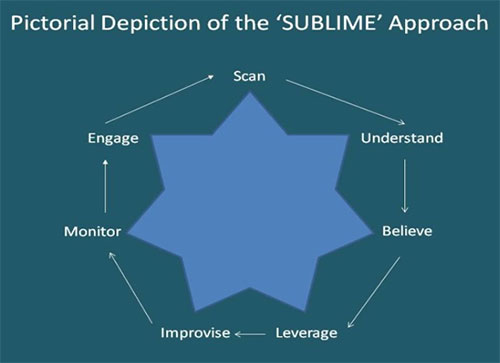‘SUBLIME’ Approach to Organizational Transformation in the Digital World
By Murad Salman Mirza
When viewed through the digital lens by an emboldened customer willing to switch brand loyalties for ‘peace of mind’ via the positive benefits of technological innovation, the business world can seem woefully small—and vulnerable.
This perception is both accurate and driven by a a steady shift towards extremities in terms of reacting to the presence or absence of ‘delight’ factors in products and services. This, in turn, fuels the need for previously secure and reputed companies to rethink their previously competitive strategies.
The following ‘SUBLIME’ approach is presented as a guide for leading such a transformation:

Brief Explanation of the ‘SUBLIME’ Terminology
- Scan: This refers to a proactively maintaining situational awareness of the initiatives being taken by the current/potential competitors to develop “breakthrough” technologies. It involves the use of appropriate methods (e.g., PESTLE Analysis, Online Assets) to gauge the disruptive potential of such technologies while they are still in their infancy stage. The result of such an exercise should be an insightful Business Environmental Scan report for senior management for consider and minimize/neutralize the risk to the organization.
- Understand: This refers to achieving a clear comprehension of the current ability of the organization to meet the challenges identified by the Business Environmental Scan report. Such an understanding can be done with the help of suitable analytical tools, such as SWOT Analysis or Force-field Analysis. The result of this exercise should be presented to the senior management and the functional heads concerned. This can take the form of a Business Competitiveness Imperatives report for developing effective strategies, SMART objectives and congruent action plans that are supported by adequate resources to systematically overcome identified challenges.
- Believe: This refers to inculcating a realistic level of self-belief throughout the organization based upon a sound understanding of the inherent capabilities for meeting identified challenges. Such an exercise requires strong communication using formal and informal means, and is buoyed by a deep sense of conviction that a coalesced culture lies at its core. This should form the basis of a “rallying cry” for uniting all factions to ensure the attainment of desired organizational goals and serve as a harbinger for transparent practices to reinforce the psychological contract.
- Leverage: This refers to the optimum use of inherent strengths and capabilities of the organization in achieving desired goals. It also entails having a clear idea of areas for improvement and the effective resolution of existing impediments. Such an initiative requires synergistic collaboration between a suitably trained and motivated workforce that can efficiently execute action plans devised under strategic imperatives and within the available/accessible resources. Care should be taken to avoid a clash of functional authorities and to find a balance between the needs and wants of key stakeholders.
- Improvise: This refers to the flexibility and adaptability embedded within the implemented action plans. It requires a high level of self-belief in the decision-makers—who have in turn been granted a liberal threshold by the senior management for the tolerance of mistakes. Such an exercise should take into account the principles of prudent risk management and a healthy respect for navigating in precarious situations. Care should be taken to avoid extensive improvisation since it may be indicative of poor planning and lead to a dilution of efforts in reaching the desired goals.
- Monitor: This refers to the oversight required to ensure that the expectations from the implementation of action plans are being met consistently and that timely corrective/preventive actions are being taken to ensure the fulfillment of strategic imperatives within the agreed timelines. Such an exercise needs to be carried out by suitably qualified and authorized individual who has an uncontaminated mandate for achieving desired results with impartiality, forthrightness and a keen sense of purpose. Clear accountabilities should be established as a cornerstone for success.
- Engage: This refers to coalescing the workforce into a productive coalition that is singularly aligned and committed to meeting the desired organizational goals. Such an exercise requires a clear vision, untainted empowerment, rampant integrity, enriched diversity and inclusion practices, reward and recognition equity, nonpartisan accountability and lucid optimization of organizational structures/processes/policies/procedures/roles. (The key challenge is to channel positive energy into enduring “Organizational Citizenship Behaviour.” Suitable formal and informal measures should also be in place to guard against the creeping of disengagement/apathy and its timely neutralization.
Parting Thoughts: SUBLIME Agility
The ‘SUBLIME’ approach is designed for a digital world that does not pay heed to tradition, sheds conventional thinking, seeks seamless gratification, pledges loyalty to technological innovation and punishes complacency with extinction. Consequently, organizational agility is required for maintaining competitiveness and the most nimble organizations are leading the way, accordingly.
Are you one of them?
Murad Salman Mirza is an innovative thinker and an astute practitioner of areas within and associated with the fields of organizational development, talent management and business transformation. He has lived, studied and served in different regions of the world, including the US, Australia, South Asia and the Middle East. Murad has more than 15 years of multi-disciplinary experience and has rich exposure to multiple sectors within the corporate world. Currently, he is engaged as a Board Member with two US-based organizations. His LinkedIn profile can be viewed at: Murad Salman Mirza.







